Practice Note on Child Development
Common child development domains in practice
RECEs understand the importance of play for children’s development; in many ways, they are linked and happening simultaneously. Dr. Jean Clinton (2013) says that areas of child development are also “interconnected and developing together — emotions, language, thinking — rendering it ineffective to focus on one area without the others” (The Power of Positive Adult Child Relationships: Connection is the Key, p. 5).
How Does Learning Happen? (HDLH?) (2014) states that if educators only pay attention to the “traditional” child development domains — social, emotional, physical, cognitive, communication and language — it wouldn’t capture the entire picture. HDLH? (2014) says “the creative, aesthetic, and spiritual dimensions of experience must also be considered,” (p. 17) as well as the significance of developing a positive self-identity. This is explored further in the Practice Guideline on Child Development (2022).
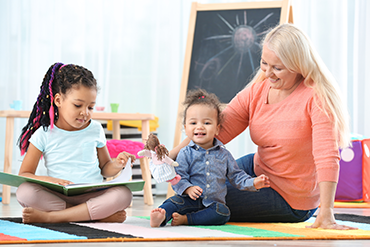
For many working in the early learning and child care sector, child development brings to mind common developmental domains, such as social and emotional development; cognitive development; communication and language development; and physical development.
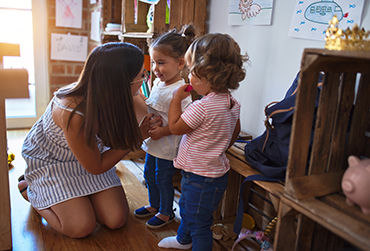
Social and emotional development
Social and emotional health and well-being may be one of the most important areas of child development. Having a sense of belonging offers children stability which can support all other areas of a child’s life and learning. HDLH? (2014) says that “as children engage in various forms of social play and are supported to recognize the varied capabilities and characteristics of other children, they learn to get along with others; to negotiate, collaborate, and communicate; and to care for others” (p. 24).
To support children’s social and emotional development, RECEs:
- Greet and welcome children, and ensure each child feels important when they come into the space;
- Get to know children: respond to their cues, interact with them, listen to their stories and ideas, and ask open-ended questions related to what they hear or sense from children’s silence, movement or body language;
- Help children understand and articulate their emotions, build confidence and form a positive self-identity. Learn more about the pedagogy of listening in the Practice Guideline on Pedagogical Practice (2020).
- Support the development of self-regulation to help children make and sustain friendships.
- Plan predictable transitions, routines and schedules that allow for flexibility to support a child and the group as a whole.
- Co-create environments that belong to everyone in the learning community.
- Promote the full participation of all children.
- Build and maintain responsive, authentic partnerships.
- Generate positive collaborative relationships with colleagues to support the social and emotional well-being of the learning community.
Cognitive development
Cognition is not solely about memorizing information or mastering certain milestones. While learning different concepts and grasping ideas is important, the focus of cognitive development is grounded in the process of learning and the idea that children are competent critical thinkers capable of solving problems on their own, with peers, with educators and by engaging with the environment.
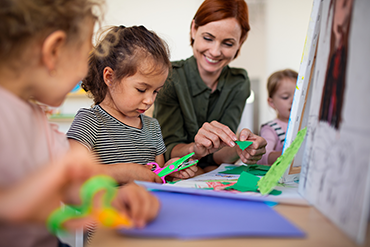
To support children’s cognitive development, RECEs:
- Generate discussions with and among children. Talk with them and ask them thought provoking, open-ended questions to promote comprehension, reasoning, prediction, critical thinking and decision-making skills.
- Challenge children to problem solve by encouraging them to use their own resources or come to solutions with their peers and educators.
- Encourage children to try new things and support them in taking healthy risks that deepen their sense of confidence.
- Listen and respond to children’s cues, statements and inquiries. Validate children’s feelings which, in turn, promotes feelings of well-being that contribute to cognitive flexibility.
- Support children’s ability to engage in critical thinking throughout the day (e.g., transitions, outdoor play, during a learning activity, at rest or during meal time).
- Promote an understanding of sequences and patterns in creative ways that engage all children.
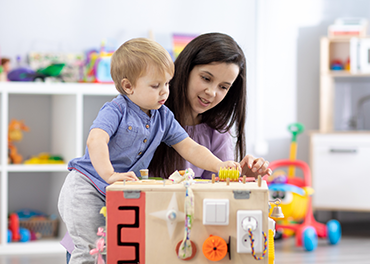
Communication and language development
- Verbal communication which can include spoken word, questioning, songs and storytelling. It involves listening, asking questions and generated conversations and stories.
- Non-verbal communication: which consists of body language, movement, gestures, body and facial expressions, and silences.
To support children’s communication and language development, RECEs:
- Respond to and observe children’s body language, statements, questions and cues.
- Engage and generate conversations with individual and groups of children.
- Learn about children and families and what kind of communication is essential for them.
- Find out what language(s) children speak and what language(s) is used at home.
- Seek ways to incorporate a child’s language and communication preferences into all aspects of the daily program.
- Demonstrate a commitment to address the unique rights and needs of Indigenous children and their families, which includes languages (Ethic A).
- Tell stories and sing regularly with children to support them in acquiring and comprehending language(s), vocabulary and how to form sentences.
Remember, families and children communicate in different ways; therefore, children may respond to or feel more comfortable using any number of differing cues. Keep the following in mind when you engage in communication with children and families:
| • eye contact • touch • light and sound |
• physical cues and body movements • facial expressions • Sign language |
• words, stories or songs • body proximity (sitting beside them, crouching down, standing over them) |
Physical development
To support children’s physical development, RECEs:
- Understand the importance of children’s brain development:
- RECEs have a unique role in that they work directly with children during some of the most influential years of brain development. Dr. Jean Clinton has affectionately referred to RECEs as ‘neuroplasticians.’
- They also engage in serve and return: an active process of responding to children’s facial cues or expressions, coos, words and/or songs. It’s viewed as a way of paying attention to what a child is communicating and responding with interest, care, love and touch. Here, the connection to communication and language and social emotional development is demonstrated, illustrating that separating domains can limit the view of the developing child.
- Support the development of children’s growing bodies. This can be through activities such as:
- planning and preparing nutritious snacks and meals;
- ensuring children have adequate quiet and rest times;
- promoting fine motor skills in activities and through self-help skills; and/or
- encouraging gross motor skills to support coordination, confidence and movement.
Consider the ways that developmental domains can intersect. One area of development may blend into another or multiple areas. For example, snack or meal time is considered a time to promote children’s physical development. Consider how snack or meal time can contribute to the following domains: language and communication, social and emotional and cognitive development.
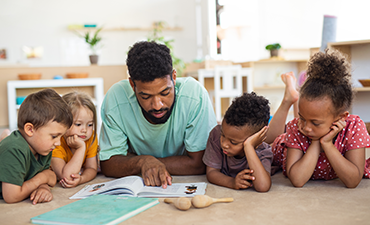
Engage in conversations with colleagues about how you are currently supporting children’s overall development in your practice setting. Think about the ways one activity can support a child’s overall development. For example, story time:
Social and emotional: seeing and hearing about the lives of characters and relating to them; being and talking with friends; or laughing, smiling and building a sense of belonging through community.
Cognitive: exploring patterns or textures, critical thinking, problem solving, anticipation of storyline and decision making skills.
Communication and language: discussing the storyline, asking questions, waiting for cues and listening to the educator and their peers.
Physical: turning the pages; acting out the storyline or jumping in place like the character; using finger puppets; being in the space in a way that is comfortable for their body; having a bottle or snack; or falling asleep during story time
What other areas of child development might storytelling promote?
To promote healthy child development and well-being, RECEs:
- hold all children in high regard and support their sense of dignity by treating them with integrity and respect;
- understand that children develop in different ways;
- know that children and families come from diverse social contexts, family structures and socio-economic circumstances, and are impacted by factors such as race, disability, ability, trauma, age and religion;
- create equitable environments that dismantle racism and discrimination, and promote inclusion, feelings of belonging and well-being; and
- stay informed about the ways that beliefs and biases, discrimination and racism powerfully — subtly or obviously — function in society and communities, including in early learning environments.